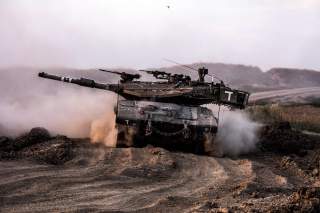Everything Israel's Gaza Wars Can Teach America
Lots to learn for the Pentagon.
What can the U.S. military learn from Israeli military operations in Gaza?
Plenty—and yet not much, according to a new study by RAND Corporation, which examined Operation Cast Lead in 2009 and Operation Protective Edge in 2014.
For starters, smart weapons are no panacea. The Israel Defense Forces (IDF) attempted to destroy Hamas rocket launchers and tunnels with airpower alone (surprising in light of the failure of such an approach in the 2006 Lebanon War). Lack of success meant ground troops had to be sent in.
The failure of airpower meant the revival of artillery. The IDF barely used artillery in 2009, but used lots of big guns in 2014. “On a technical and tactical level, the IDF’s use of artillery support was impressive,” RAND noted. “It increased its use of precision artillery from earlier campaigns and reduced the minimum safe distances for providing fire support. Artillery fire often proved quicker and more responsive than other means of firepower, such as CAS [close air support].”
Armor also proved its worth in Gaza. “Before Protective Edge, the IDF invested in intelligence and airpower, often at the expense of particularly heavy armor,” RAND found. Or as Israeli sources told RAND, “Half a year before, they closed the Namer [a tank converted into a troop carrier] and we said it was a mistake; and immediately after, they reopened the project. You need protection. Mobility is protection.”
In turn, armor needs active protection systems. “there was near—universal consensus among IDF officers and outside analysts interviewed for this report that vehicles equipped with the Trophy system stood a better chance of surviving not only RPG fire, but also the Kornet ATGM [anti-tank guided missile],” RAND found. “Indeed, according to some accounts, there were at least 15 instances of active protection systems intercepting Kornet-style missiles.” Another unexpected benefit was that the sensors on the Trophy also proved useful in detecting the location of hostile fire.
However, neither smart weapons nor artillery can stop that most formidable of twenty-first century weapons: lawfare, or the use of international law and public opinion to stymie an adversary's superior firepower. Under intense media scrutiny, the IDF grappled with how to destroy rocket launchers that Hamas had emplaced in densely populated civilian areas. To its credit, Israel tried a variety of means to avoid civilian casualties, including calling residents on their phones to evacuate, social media and the memorable “door knocker” inert bombs landing on roofs as a signal to get out of the target zone. Lawyers even reviewed targeting decisions, and yet Israeli still suffered a public relations disaster, including public and UN accusations of war crimes. Now the IDF General Staff is adding a lawfare section. “For better or worse, lawfare is here to stay, and the IDF— like all Western militaries—will have to wrestle with its implications in any future operation,” RAND concludes.
RAND concludes that at the tactical level, the IDF’s experience in Gaza offers limited lessons for the United States. The IDF is a smaller force from a smaller nation that can more quickly mobilize and dispatch reserve troops fighting close to their homes, which also makes logistics easier. The IDF is also organized as pure brigades of armor and infantry, rather than combined-arms formations (though Israeli commanders would like to use the U.S. joint force approach, RAND noted).
But on the broader level, the United States and Israel confront similar challenges. Both face hybrid warfare against quasimilitary opponents operating amid dense civilian populations. And most importantly, both are sensitive to taking casualties. In that sense, one finding of the study is particularly significant: “In the end, the Israeli public tolerated military casualties, provided the IDF achieved tangible results. As one senior Israeli policy maker noted, ‘Israel needs to feel it achieved something, and then the public won’t care about the Israeli casualties. It very much depends on the results of the operation.’”
Michael Peck is a contributing writer for the National Interest. He can be found on Twitter and Facebook.
Image: Flickr / Israel Defense Forces

